Life Cycle Assessment of the Domestic Micro Heat and Power Generation Proton Exchange Membrane Fuel Cell in Comparison with the Gas Condensing Boiler Plus Electricity from the Grid
Abstract
:1. Introduction
2. Materials and Methods
3. Results
3.1. PEMFC Compared to a Conventional Energy Supply System
3.2. Environmental Profile of the PEMFC during the Manufacturing Phase
3.3. Comparative Life Cycle Assessment Results: Use Phase
3.4. Sensitivity Analyses
4. Discussion
5. Conclusions
Supplementary Materials
Author Contributions
Funding
Institutional Review Board Statement
Informed Consent Statement
Data Availability Statement
Conflicts of Interest
References
- Statista. Verteilung der Energiebedingten CO2-Emissionen Weltweit nach Sektor im Jahr 2018; Statista: Hamburg, Germany, 2020. [Google Scholar]
- Umweltbundesamt. Nationale und Europäische Klimaziele; Umweltbundesamt: Dessau-Roßlau, Germany, 2021. [Google Scholar]
- Dodds, P.E.; Staffell, I.; Hawkes, A.D.; Li, F.; Grünewald, P.; McDowall, W.; Ekins, P. Hydrogen and fuel cell technologies for heating. Int. J. Hydrogen Energy 2015, 40, 2065–2083. [Google Scholar] [CrossRef]
- Palkowski, C. Dynamische Prüfmethode zur Ermittlung der Saisonalen Wärmepumpeneffizienz; Technischen Universität München: München, Germany, 2019. [Google Scholar]
- Chwieduk, D. Towards sustainable-energy buildings. Appl. Energy 2003, 76, 211–217. [Google Scholar] [CrossRef]
- Bozorgmehri, S.; Heidary, H.; Salimi, M. Market diffusion strategies for the PEM fuel cell-based micro-CHP systems in the residential sector: Scenario analysis. Int. J. Hydrogen Energy 2023, 48, 3287–3298. [Google Scholar] [CrossRef]
- DIRECTIVE 2009/125/EC of the EUROPEAN PARLIAMENT and of the COUNCIL of 21 October 2009 Establishing a Framework for the Setting of Ecodesign Requirements for Energy-Related Products (Recast). 2013. Available online: https://eur-lex.europa.eu/legal-content/EN/ALL/?uri=celex%3A32009L0125 (accessed on 25 January 2024).
- REGULATION (EU) 2017/1369 of the EUROPEAN PARLIAMENT and of the COUNCIL of 4 July 2017 setting a framework for energy labelling and repealing Directive 2010/30/EU. EU 2017/1369, the EUROPEAN PARLIAMENT and the COUNCIL of the EUROPEAN UNION. Available online: https://eur-lex.europa.eu/eli/reg/2017/1369/oj (accessed on 25 January 2024).
- European Commission. Recommendation on the Use of Environmental Footprint Methods; European Commission: Brussels, Belgium, 2021. [Google Scholar]
- Lou, T.; Yin, Y.; Wang, J. Recent advances in effect of biochar on fermentative hydrogen production: Performance and mechanisms. Int. J. Hydrogen Energy 2024, 57, 315–327. [Google Scholar] [CrossRef]
- IEA. World Energy Outlook 2018; International Energy Agency: Paris, France, 2018. [Google Scholar]
- IEA. Covid Crisis Deepens Energy Efficiency Slowdown, Intensifying Need for Urgent Action; International Energy Agency: Paris, France, 2020. [Google Scholar]
- Valente, A.; Iribarren, D.; Dufour, J. End of life of fuel cells and hydrogen products: From technologies to strategies. Int. J. Hydrogen Energy 2019, 44, 20965–20977. [Google Scholar] [CrossRef]
- Gencoglu, M.T.; Ural, Z. Design of a PEM fuel cell system for residential application. Int. J. Hydrogen Energy 2009, 34, 5242–5248. [Google Scholar] [CrossRef]
- Hou, X.; Sun, R.; Huang, J.; Geng, W.; Li, X.; Wang, L.; Zhang, X. Energy, economic, and environmental analysis: A study of operational strategies for combined heat and power system based on PEM fuel cell in the East China region. Renew. Energy 2024, 223, 120023. [Google Scholar] [CrossRef]
- Arsalis, A.; Nielsen, M.P.; Kær, S.K. Modeling and off-design performance of a 1kWe HT-PEMFC (high temperature-proton exchange membrane fuel cell)-based residential micro-CHP (combined-heat-and-power) system for Danish single-family households. Energy 2011, 36, 993–1002. [Google Scholar] [CrossRef]
- Bachmann, T.M.; Carnicelli, F.; Preiss, P. Life cycle assessment of domestic fuel cell micro combined heat and power generation: Exploring influencing factors. Int. J. Hydrogen Energy 2019, 44, 3891–3905. [Google Scholar] [CrossRef]
- Notter, D.A.; Kouravelou, K.; Karachalios, T.; Daletou, M.K.; Haberland, N.T. Life cycle assessment of PEM FC applications: Electric mobility and μ-CHP. Energy Environ. Sci. 2015, 8, 1969–1985. [Google Scholar] [CrossRef]
- Abdelkareem, M.A.; Elsaid, K.; Wilberforce, T.; Kamil, M.; Sayed, E.T.; Olabi, A. Environmental aspects of fuel cells: A review. Sci. Total Environ. 2021, 752, 141803. [Google Scholar] [CrossRef] [PubMed]
- Zhao, G.; Kraglund, M.R.; Frandsen, H.L.; Wulff, A.C.; Jensen, S.H.; Chen, M.; Graves, C.R. Life cycle assessment of H2O electrolysis technologies. Int. J. Hydrogen Energy 2020, 45, 23765–23781. [Google Scholar] [CrossRef]
- Parise, J.A.R.; Vargas, J.V.C.; Marques, R.P. Fuel Cells and Cogeneration. J. Fuel Cell Sci. Technol. 2008, 5, 034002. [Google Scholar] [CrossRef]
- Lotrič, A.; Sekavčnik, M.; Kuštrin, I.; Mori, M. Life-cycle assessment of hydrogen technologies with the focus on EU critical raw materials and end-of-life strategies. Int. J. Hydrogen Energy 2021, 46, 10143–10160. [Google Scholar] [CrossRef]
- Mori, M.; Stropnik, R.; Sekavčnik, M.; Lotrič, A. Criticality and Life-Cycle Assessment of Materials Used in Fuel-Cell and Hydrogen Technologies. Sustainability 2021, 13, 3565. [Google Scholar] [CrossRef]
- Riemer, M.; Duval-Dachary, S.; Bachmann, T.M. Environmental implications of reducing the platinum group metal loading in fuel cells and electrolysers: Anion exchange membrane versus proton exchange membrane cells. Sustain. Energy Technol. Assess. 2023, 56, 103086. [Google Scholar] [CrossRef]
- Dhimish, M.; Vieira, R.G.; Badran, G. Investigating the stability and degradation of hydrogen PEM fuel cell. Int. J. Hydrogen Energy 2021, 46, 37017–37028. [Google Scholar] [CrossRef]
- Wu, J.; Yuan, X.Z.; Martin, J.J.; Wang, H.; Zhang, J.; Shen, J.; Wu, S.; Merida, W. A review of PEM fuel cell durability: Degradation mechanisms and mitigation strategies. J. Power Sources 2008, 184, 104–119. [Google Scholar] [CrossRef]
- Yan, S.; Yang, M.; Sun, C.; Xu, S. Liquid Water Characteristics in the Compressed Gradient Porosity Gas Diffusion Layer of Proton Exchange Membrane Fuel Cells Using the Lattice Boltzmann Method. Energies 2023, 16, 6010. [Google Scholar]
- Gulotta, T.M.; Salomone, R.; Lanuzza, F.; Saija, G.; Mondello, G.; Ioppolo, G. Life Cycle Assessment and Life Cycle Costing of unitized regenerative fuel cell: A systematic review. Environ. Impact Assess. Rev. 2022, 92, 106698. [Google Scholar] [CrossRef]
- Jamil, A.; Rafiq, S.; Iqbal, T.; Khan, H.A.A.; Khan, H.M.; Azeem, B.; Mustafa, M.Z.; Hanbazazah, A.S. Current status and future perspectives of proton exchange membranes for hydrogen fuel cells. Chemosphere 2022, 303, 135204. [Google Scholar] [CrossRef] [PubMed]
- Schmidt Rivera, X.C.; Topriska, E.; Kolokotroni, M.; Azapagic, A. Environmental sustainability of renewable hydrogen in comparison with conventional cooking fuels. J. Clean. Prod. 2018, 196, 863–879. [Google Scholar] [CrossRef]
- Pehnt, M. Life cycle assessment of fuel cells and relevant fuel chains. In Proceedings of the Hyforum the International Hydrogen Energy Forum 2000, München, Germany, 11–15 September 2000. [Google Scholar]
- Cooper, J.S.; Grot, S.; Hartnig, C. 5—Recycling and life cycle assessment of fuel cell materials. In Polymer Electrolyte Membrane and Direct Methanol Fuel Cell Technology; Hartnig, C., Roth, C., Eds.; Woodhead Publishing: Sawston, UK, 2012; pp. 117–134. [Google Scholar]
- Melideo, D.; Ortiz-Cebolla, R.; Weidner, E. Life Cycle Assessment of Hydrogen and Fuel Cell Technologies: Inventory of Work Performed by Projects Funded under FCH JU; JRC Technical Report; Publications Office of the European Union: Luxembourg, 2020. [Google Scholar]
- ISO 14040:2006 + Amd 1:2020; Environmental Management—Life Cycle Assessment—Principles and Framework. German version EN ISO 14040:2006 + A1:2020; Beuth Publishing Din: Berlin, Germany, 2021. [CrossRef]
- ISO 14044:2006 + Amd 1:2017 + Amd 2:2020; Environmental Management—Life Cycle Assessment—Requirements and Guidelines. German version EN ISO 14044:2006 + A1:2018 + A2:2020; Beuth Publishing Din: Berlin, Germany, 2021. [CrossRef]
- Lozanovski, A.; Schuller, O.; Faltenbacher, M.; Bode, M.; Finkbeiner, M.; Chomkhamsri, K. Guidance Document for Performing LCAs on Fuel Cells and H2 Technologies. Guidance Document for Performing LCA on Hydrogen Production Systems. 2011. Available online: https://hytechcycling.eu/wp-content/uploads/HY-Guidance-Document.pdf (accessed on 25 January 2024).
- Masoni, P.; Zamagni, A.; Bode, M.; Finkbeiner, M.; Chomkhamsri, K. Guidance Document for Performing LCAs on Fuel Cells and H2 Technologies. Guidance Document for Performing LCA on Fuel Cells. 2011. Available online: https://hytechcycling.eu/wp-content/uploads/FC-Guidance-Document.pdf (accessed on 25 January 2024).
- Thilo Kupfer, D.M.B.; Colodel, C.M.; Kokborg, M.; Schöll, S.; Matthias Rudolf, D.U.B.; Bosch, F.; Gonzalez, M.; Jasmin, O.S.; Hengstler, A.S.; Thylmann, D.; et al. GaBi Databases & Modelling Principles. 2021, p. 229. Available online: https://sphera.com/wp-content/uploads/2020/04/Modeling-Principles-GaBi-Databases-2021.pdf (accessed on 25 January 2024).
- European Commission. ILCD Handbook: General Guide for Life Cycle Assessment—Detailed Guidance; Publications Office of the European Union: Luxembourg, 2010. [Google Scholar]
- Wang, C.; Zhou, S.; Hong, X.; Qiu, T.; Wang, S. A comprehensive comparison of fuel options for fuel cell vehicles in China. Fuel Process. Technol. 2005, 86, 831–845. [Google Scholar] [CrossRef]
- Wee, J.-H. Applications of proton exchange membrane fuel cell systems. Renew. Sustain. Energy Rev. 2007, 11, 1720–1738. [Google Scholar] [CrossRef]
- Jo, A.; Oh, K.; Lee, J.; Han, D.; Kim, D.; Kim, J.; Kim, B.; Kim, J.; Park, D.; Kim, M.; et al. Modeling and analysis of a 5 kWe HT-PEMFC system for residential heat and power generation. Int. J. Hydrogen Energy 2017, 42, 1698–1714. [Google Scholar] [CrossRef]
- Chandan, A.; Hattenberger, M.; El-kharouf, A.; Du, S.; Dhir, A.; Self, V.; Pollet, B.G.; Ingram, A.; Bujalski, W. High temperature (HT) polymer electrolyte membrane fuel cells (PEMFC)—A review. J. Power Sources 2013, 231, 264–278. [Google Scholar] [CrossRef]
- Wang, S.; Hu, X.; Zhou, Z.; Wang, Q.; Ye, K.; Sui, S.; Hu, M.; Jiang, F. Critical performance comparisons between the high temperature and the low temperature proton exchange membrane fuel cells. Sustain. Energy Technol. Assess. 2023, 60, 103529. [Google Scholar] [CrossRef]
- Pasupathi, S.; Calderon Gomez, J.C.; Su, H.; Reddy, H.; Bujlo, P.; Sita, C. Chapter 5—Stationary HT-PEMFC-Based Systems—Combined Heat and Power Generation. In Recent Advances in High-Temperature PEM Fuel Cells; Pasupathi, S., Calderon Gomez, J.C., Su, H., Reddy, H., Bujlo, P., Sita, C., Eds.; Academic Press: Cambridge, MA, USA, 2016; pp. 55–77. [Google Scholar] [CrossRef]
- Kebede, A.A.; Coosemans, T.; Messagie, M.; Jemal, T.; Behabtu, H.A.; Van Mierlo, J.; Berecibar, M. Techno-economic analysis of lithium-ion and lead-acid batteries in stationary energy storage application. J. Energy Storage 2021, 40, 102748. [Google Scholar] [CrossRef]
- Sphera Solution Inc. LCA for Experts (GaBi), Version: 10.5.0.78; Sphera Solution Inc.: Leinfelden-Echterdingen, Germany, 2021. [Google Scholar]
- Ahn, S.Y.; Shin, S.J.; Ha, H.Y.; Hong, S.A.; Lee, Y.C.; Lim, T.W.; Oh, I.H. Performance and lifetime analysis of the kW-class PEMFC stack. J. Power Sources 2002, 106, 295–303. [Google Scholar] [CrossRef]
- Wong, K.H. Mitigation of Chemical Membrane Degradation in Fuel Cells: Understanding the Effect of Cell Voltage and Iron Ion Redox Cycle. Chem. Eur. 2015, 1072–1082. [Google Scholar] [CrossRef]
- Ecology|U.S. Department of the Interior. CML-IA Characterisation Factors; Univeriy Leiden: Leiden, The Netherlands, 2016. [Google Scholar]
- Cross, H.J.; Beach, J.; Levy, L.S.; Sadhra, S.; Sorahan, T.; McRoy, C. Manufacture, Processing and Use of Stainless Steel: A Review of the Health Effects; Institute of Occupational Health, University of Birmingham: Birmingham, UK; European Confederation of Iron and Steel Industries (EUROFER): Bruxelles, Belgium, 1999. [Google Scholar]
- Saouter, E.; Biganzoli, F.; Ceriani, L.; Versteeg, D.; Crenna, E.; Zampori, L.; Sala, S.; Pant, R. Environmental Footprint: Update of Life Cycle Impact Assessment Methods—Ecotoxicity Freshwater, Human Toxicity Cancer, and Non Cancer; JRC Technical Report; Publications Office of the European Union: Luxembourg, 2020. [Google Scholar]
- Sala, S.; Biganzoli, F.; Mengual, E.S.; Saouter, E. Toxicity impacts in the environmental footprint method: Calculation principles. Int. J. Life Cycle Assess. 2022, 27, 587–602. [Google Scholar] [CrossRef]
- Marincu, C.; Dan, D.; Moga, L. Investigating the influence of building shape and insulation thickness on energy efficiency of buildings. Energy Sustain. Dev. 2024, 79, 101384. [Google Scholar] [CrossRef]
- Kiciński, W.; Dyjak, S.; Gratzke, M.; Tokarz, W.; Błachowski, A. Platinum group metal-free Fe−N−C catalysts for PEM fuel cells derived from nitrogen and sulfur doped synthetic polymers. Fuel 2022, 328, 125323. [Google Scholar] [CrossRef]
- Ma, N.; Zhao, W.; Wang, W.; Li, X.; Zhou, H. Large scale of green hydrogen storage: Opportunities and challenges. Int. J. Hydrogen Energy 2024, 50, 379–396. [Google Scholar] [CrossRef]
- Sun, C.; Negro, E.; Vezzù, K.; Pagot, G.; Cavinato, G.; Nale, A.; Herve Bang, Y.; Di Noto, V. Hybrid inorganic-organic proton-conducting membranes based on SPEEK doped with WO3 nanoparticles for application in vanadium redox flow batteries. Electrochim. Acta 2019, 309, 311–325. [Google Scholar] [CrossRef]
- Koroneos, C.; Dompros, A.; Roumbas, G.; Moussiopoulos, N. Life cycle assessment of hydrogen fuel production processes. Int. J. Hydrogen Energy 2004, 29, 1443–1450. [Google Scholar]
- Granovskii, M.; Dincer, I.; Rosen, M.A. Exergetic life cycle assessment of hydrogen production from renewables. J. Power Sources 2007, 167, 461–471. [Google Scholar] [CrossRef]
- Jia, L.; Cheng, P.; Yu, Y.; Chen, S.-H.; Wang, C.-X.; He, L.; Nie, H.-T.; Wang, J.-C.; Zhang, J.-C.; Fan, B.-G.; et al. Regeneration mechanism of a novel high-performance biochar mercury adsorbent directionally modified by multimetal multilayer loading. J. Environ. Manag. 2023, 326, 116790. [Google Scholar] [CrossRef]
- Choi, M.; Kim, M.; Sohn, Y.-J.; Kim, S.-G. Development of preheating methodology for a 5 kW HT-PEMFC system. Int. J. Hydrogen Energy 2021, 46, 36982–36994. [Google Scholar] [CrossRef]
- Pourrahmani, H.; Yavarinasab, A.; Siavashi, M.; Matian, M.; Van herle, J. Progress in the proton exchange membrane fuel cells (PEMFCs) water/thermal management: From theory to the current challenges and real-time fault diagnosis methods. Energy Rev. 2022, 1, 100002. [Google Scholar] [CrossRef]
- Viesmann. Technologie-Broschüre. Stromerzeugende Heizungen VITOVALOR; Viesmann: Allendorf, Germany, 2021. [Google Scholar]
- Destatis, S.B. Private Haushalte—Umweltökonomische Gesamtberechnungen 2019. Available online: https://www.destatis.de/DE/Themen/Gesellschaft-Umwelt/Umwelt/UGR/private-haushalte/Publikationen/Downloads/haushalte-umwelt-pdf-5851319.pdf?__blob=publicationFile (accessed on 25 January 2024).
- Uwe Bigalke, Y.Z.; Kunde, J.; Schmitt, M.; Zeng, Y.; Discher, H.; Bensmann, K.; Stolte, C. Statistiken und Analysen zur Energieeffizienz im Gebäudebestand; Der dena-Gebäudereport; Deutsche Energie-Agentur GmbH (dena): Berlin, Germany, 2015. [Google Scholar]
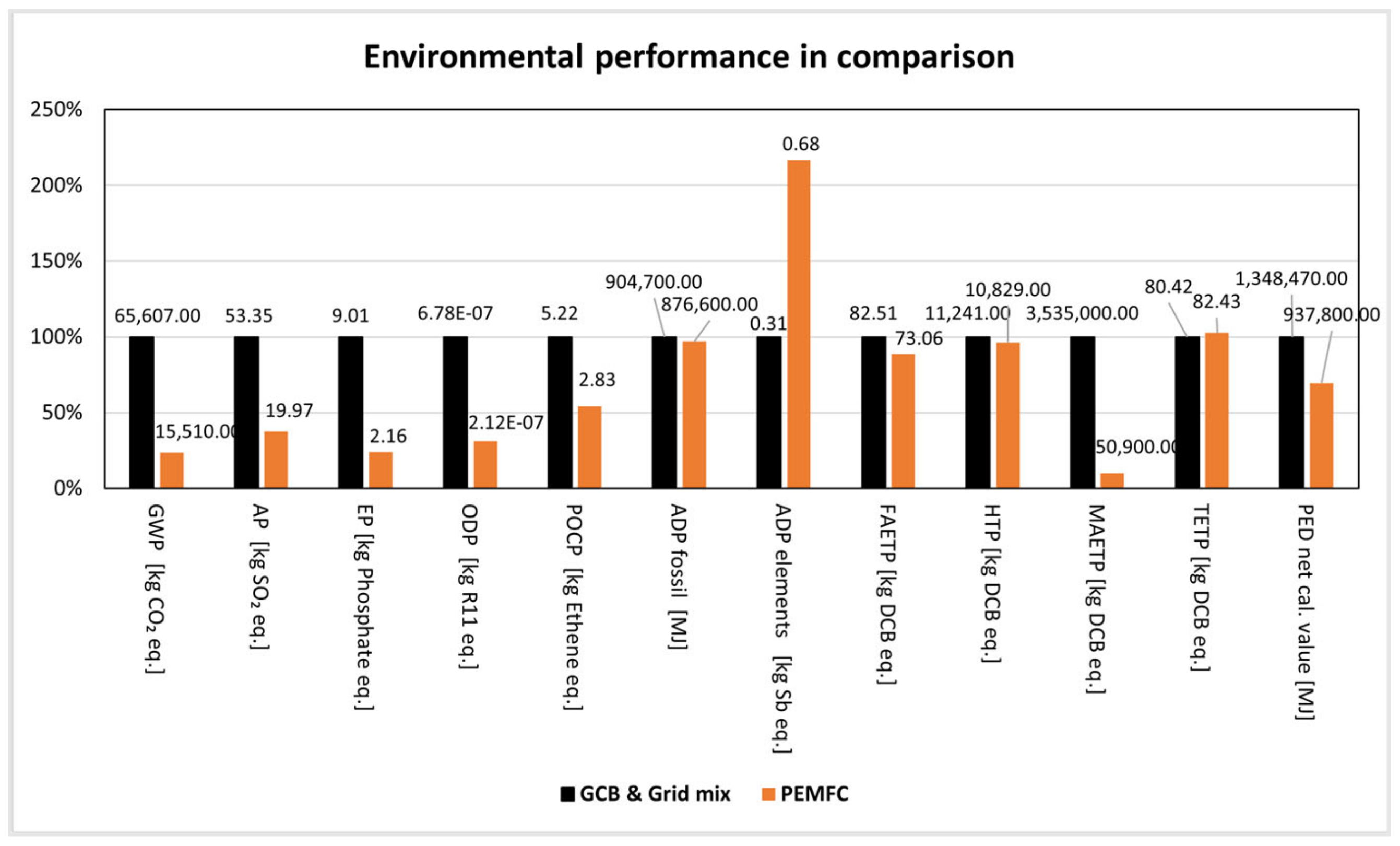
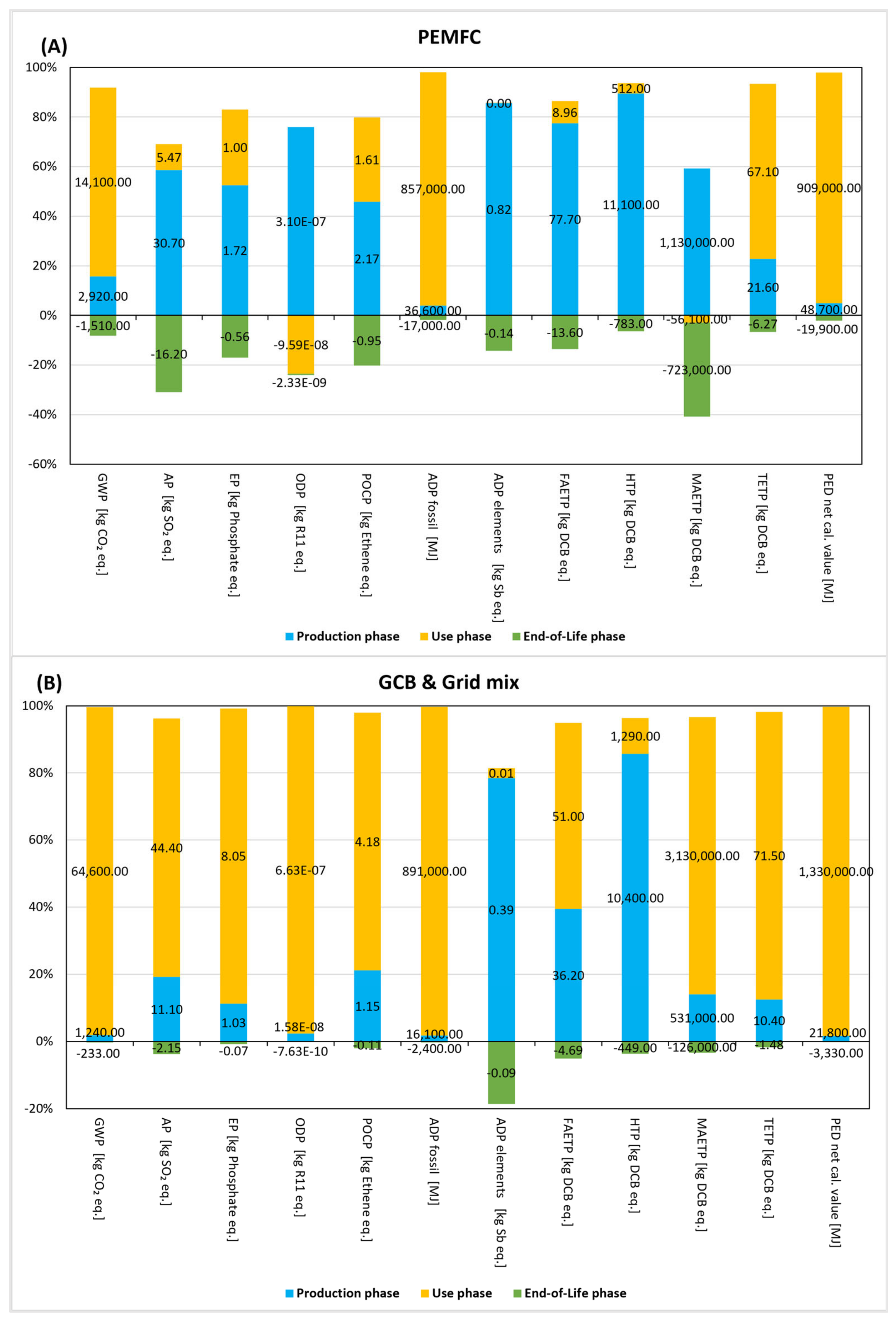

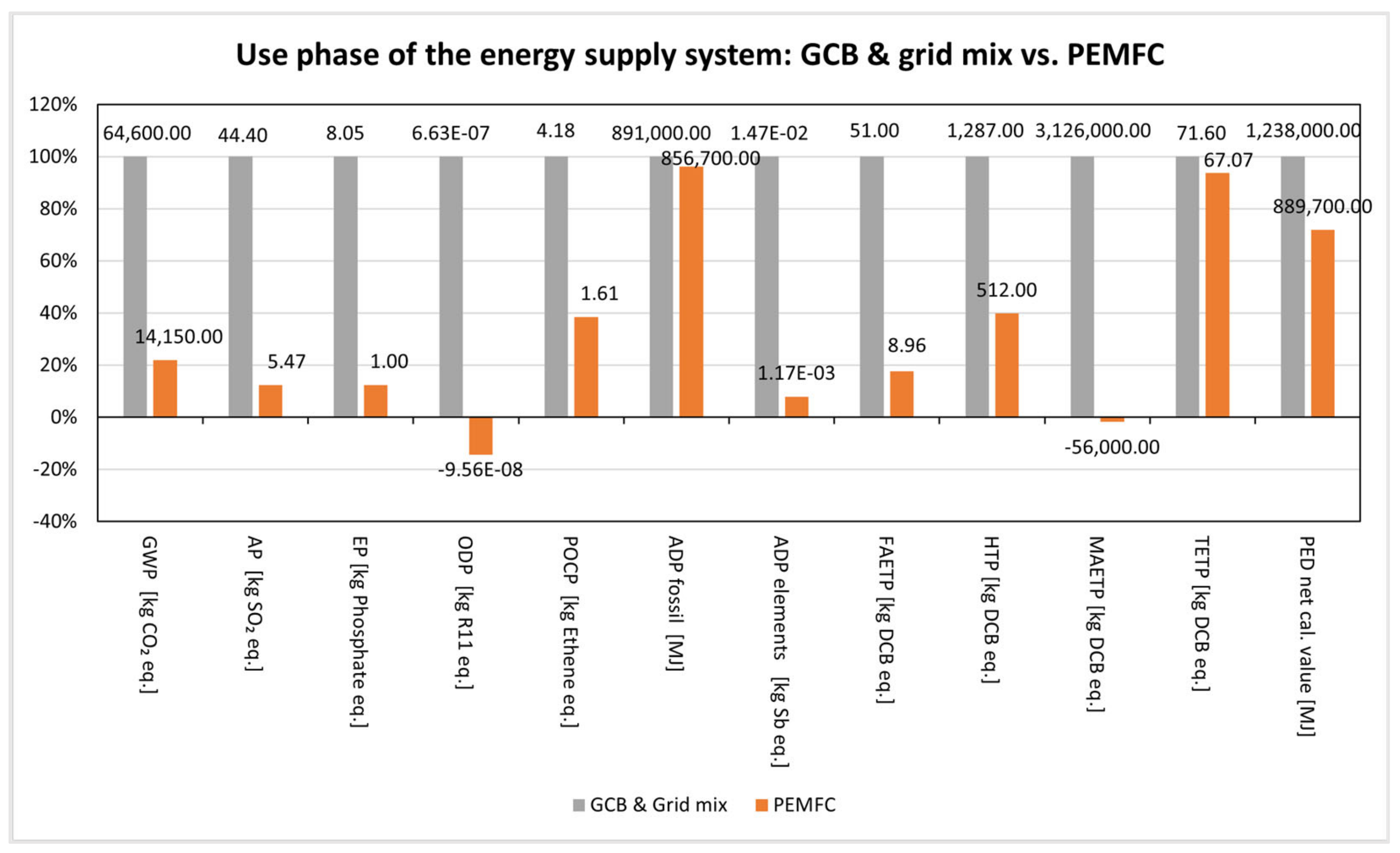
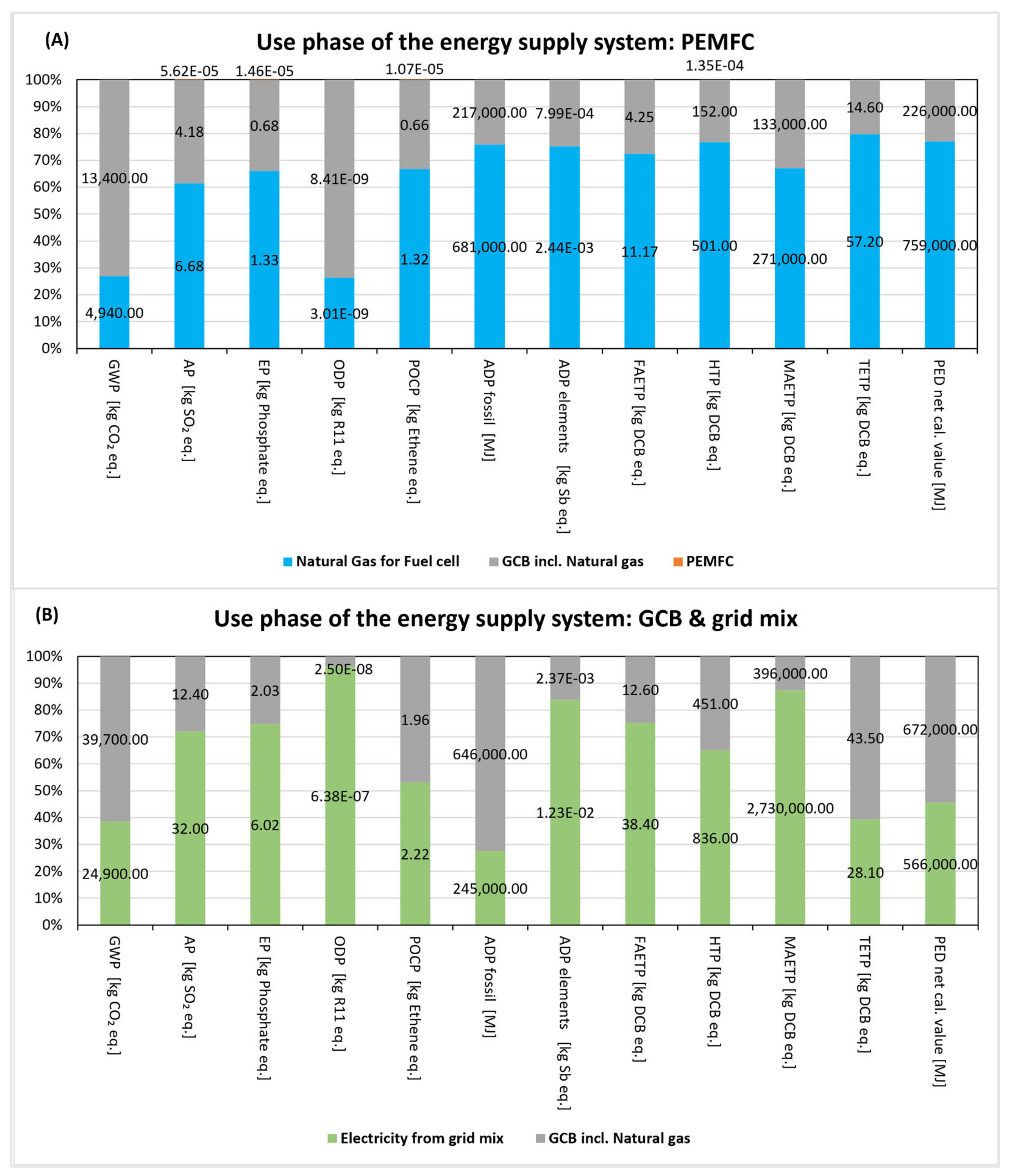

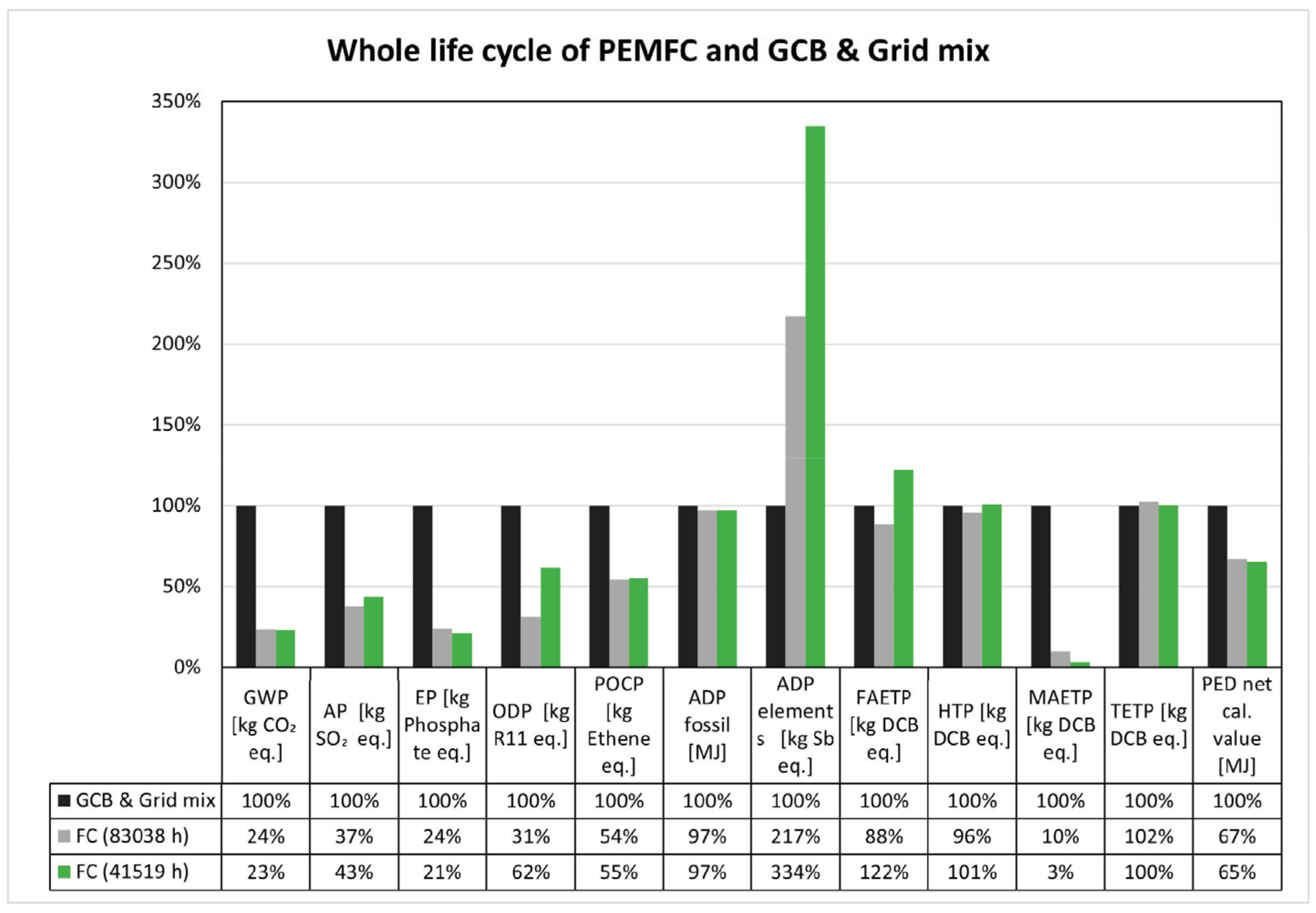
| Impact Categories | Electricity Credits |
|---|---|
| GWP [kg CO2-eq.] | −4.19 × 103 |
| AP [kg SO2-eq.] | −5.39 |
| EP [kg Phosphate eq.] | −1.01 |
| ODP [kg R11 eq.] | −1.07 × 10−7 |
| POCP [kg Ethene eq.] | −3.74 × 10−1 |
| ADP fossil [MJ] | −4.13 × 104 |
| ADP elements [kg Sb eq.] | −2.07 × 10−3 |
| FAETP [kg DCB eq.] | −6.46 |
| HTP [kg DCB eq.] | −1.41 × 102 |
| MAETP [kg DCB eq.] | −4.60 × 105 |
| TETP [kg DCB eq.] | −4.73 |
| PED net cal. value [MJ] | −9.53 × 104 |
Disclaimer/Publisher’s Note: The statements, opinions and data contained in all publications are solely those of the individual author(s) and contributor(s) and not of MDPI and/or the editor(s). MDPI and/or the editor(s) disclaim responsibility for any injury to people or property resulting from any ideas, methods, instructions or products referred to in the content. |
© 2024 by the authors. Licensee MDPI, Basel, Switzerland. This article is an open access article distributed under the terms and conditions of the Creative Commons Attribution (CC BY) license (https://creativecommons.org/licenses/by/4.0/).
Share and Cite
Slotyuk, L.; Part, F.; Schlegel, M.-C.; Akkerman, F. Life Cycle Assessment of the Domestic Micro Heat and Power Generation Proton Exchange Membrane Fuel Cell in Comparison with the Gas Condensing Boiler Plus Electricity from the Grid. Sustainability 2024, 16, 2348. https://doi.org/10.3390/su16062348
Slotyuk L, Part F, Schlegel M-C, Akkerman F. Life Cycle Assessment of the Domestic Micro Heat and Power Generation Proton Exchange Membrane Fuel Cell in Comparison with the Gas Condensing Boiler Plus Electricity from the Grid. Sustainability. 2024; 16(6):2348. https://doi.org/10.3390/su16062348
Chicago/Turabian StyleSlotyuk, Lyubov, Florian Part, Moritz-Caspar Schlegel, and Floris Akkerman. 2024. "Life Cycle Assessment of the Domestic Micro Heat and Power Generation Proton Exchange Membrane Fuel Cell in Comparison with the Gas Condensing Boiler Plus Electricity from the Grid" Sustainability 16, no. 6: 2348. https://doi.org/10.3390/su16062348








